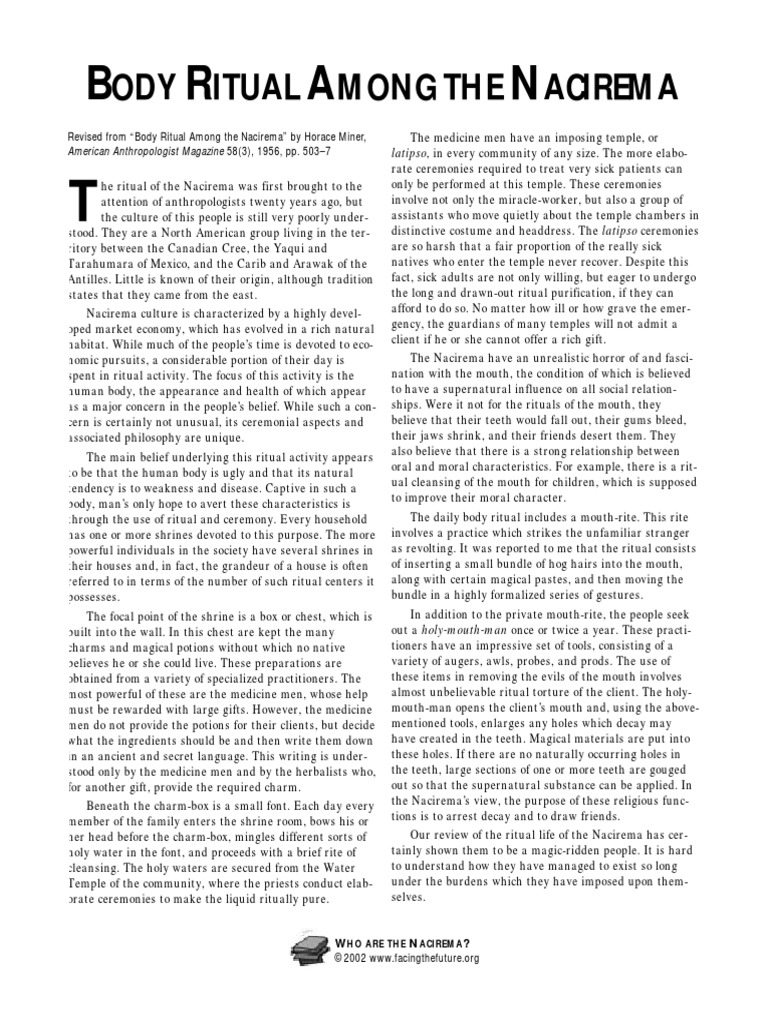Nacirema, a term derived from the spelling of “American” reversed, represents an anthropological concept that has fascinated scholars and enthusiasts alike. This construct is not a tangible location but a lens through which to view the rituals and cultural practices prevalent in American society. Delving into the Nacirema’s proverbial location on a map invites us to reflect on various dimensions of culture, ritual, and the human experience itself.
While one might seek a geographic pin on a map for a place named Nacirema, a more profound inquiry unfolds upon momentarily engaging in what this term encapsulates. The Nacirema are characterized by unique rituals focused on the national identity and cultural practices that can eclipse a simple geographical placement. This juxtaposition reveals that the real “location” of the Nacirema is not confined to coordinates but rather resides in the societal structures and norms that dictate behaviors in everyday life.
To begin exploring the Nacirema’s essence, consider what rituals represent in human society. Rituals serve as the bedrock upon which identities are constructed. In the case of Nacirema, these rituals are often laden with an ethos that revolves around notions of beauty, health, and social acceptance. Each of these aspects does not merely exist in isolation; they reflect a broader cultural discourse that can inspire fascination and scrutiny alike.
Most notably, the Nacirema engage in elaborate rites that underscore their values. For example, the ritual of daily hygiene is not merely a set of actions but a far-reaching social practice imbued with implications of status and morality. Often, observers are taken aback by the lengths to which Nacirema will go. They congregate, adorned with paraphernalia—potions and creams—believing these artifacts hold the key to an elevated self-image. In this context, one must ponder the correlation between the values celebrated in society and the actions taken by individuals to reflect those values.
A more granular observation reveals how the practices characteristic of the Nacirema can serve as a metaphorical mirror for other cultures. Take, for instance, the widespread ritualistic consumption of food. The fast-paced lifestyle of the Nacirema gives rise to dietary choices that might seem bewildering from an external perspective. Fast food, prepared with an almost ritualistic haste, highlights an intricate relationship between time, convenience, and nutrition. In this way, adherence to a value system that prizes efficiency dovetails with deeper implications about health and wellness.
Though the Nacirema are fictitious, the core theme of ritualistic behavior carries weight across global dialogues on cultural identity. In a rapidly globalizing world, people often find themselves grappling with traditions that either evolve or starkly contrast with their lived experiences. The Nacirema can serve as a conduit for examining the entanglements of modernity and tradition, thus providing deeper insights into the challenges of cultural preservation.
Mapping out the Nacirema, therefore, transcends physical geography and ventures into sociocultural territories. One begins to understand how geography shapes the rituals people embrace. The vast landscape of the United States plays a pivotal role, having given rise to an astonishing diversity of beliefs and practices. Urban centers teem with rituals enshrined in commerce, while rural settings nurture different yet equally vital customs. Thus, the Nacirema exist in a kaleidoscope of identities woven into the fabric of a continent.
In addition, the notion of place further complicates the understanding of the Nacirema. Regions are not merely demarcated by borders but are imbued with histories that shape the people inhabiting them. One can find echoes of Nacirema-esque behaviors across different regions of the United States, where local customs and traditions paint a unique portrait of cultural expression. Consider the Southern traditions steeped in hospitality versus the more fast-paced lifestyle of Northeastern urban centers—each reflecting a distinct iteration of the Nacirema ethos.
As this exploration continues, it becomes evident that the fascination with Nacirema lies in the stark contrast between day-to-day rituals and their implications. Beyond the sheer absurdity or relatability of certain practices is a deeper reflection on societal norms, the human condition, and existential questions. It prompts introspection about how daily actions influence individual identities and collective consciousness.
Moreover, this cultural inquiry leads to pressing discussions regarding consumerism, identity, and mental health. The Nacirema embody a critique of incessant consumption and its repercussions on personal well-being. The rituals underpinning consumer behavior invite serious consideration of their sustainability—socially, economically, and environmentally. The practices once solely emblematized by the Nacirema—a satire of American culture—evoke broader trends that manifest in contemporary dialogues about wellness and sustainability.
In conclusion, although one may not find Nacirema inscribed on any official map, its essence reverberates profoundly across both anthropological study and popular discourse. Enshrined in everyday rituals, cultural practices can be critical indicators of societal values and existential concerns. As the Nacirema continue to pique curiosity and provoke thought, they challenge us to interrogate our own rituals, question societal norms, and consider how we may redefine our identity in an increasingly complex world.
